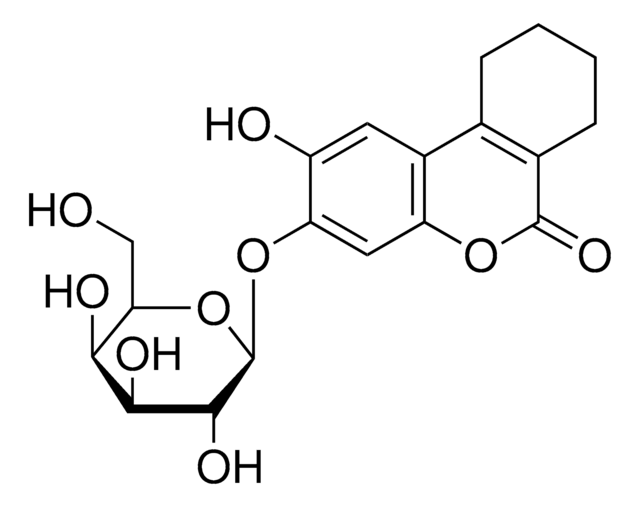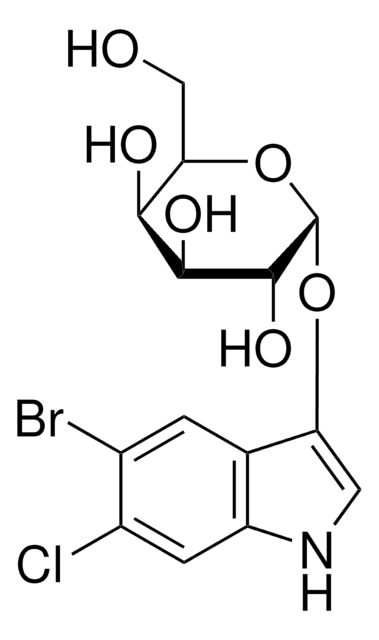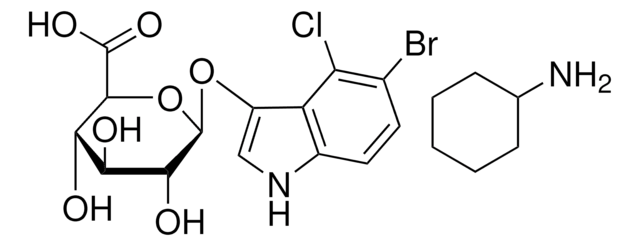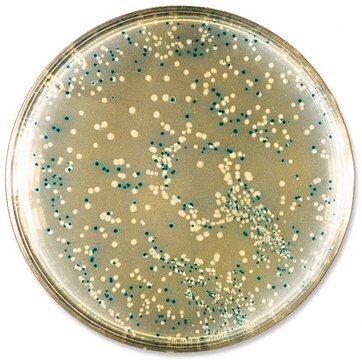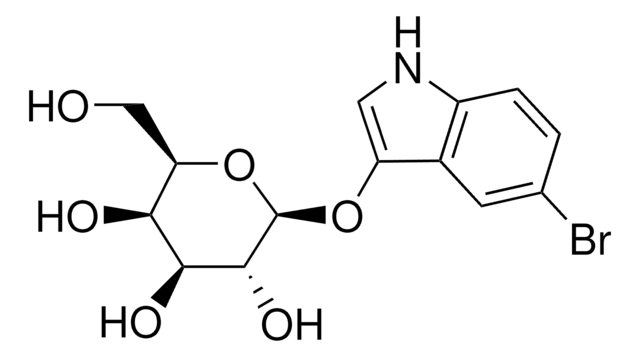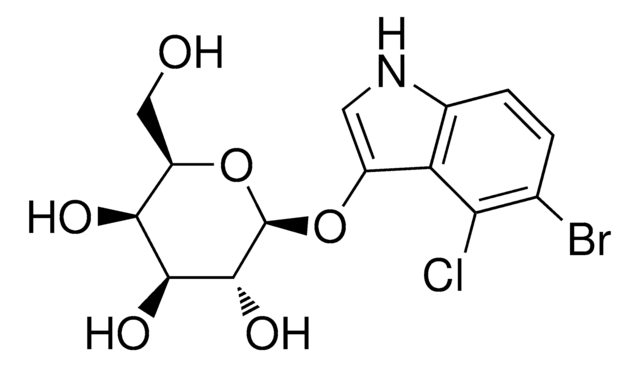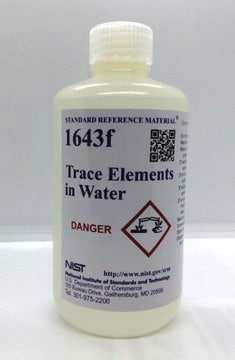推荐产品
等級
for molecular biology
無菌
non-sterile
化驗
≥95% (HPLC)
形狀
powder
IVD
not for in vitro diagnostic use
溶解度
H2O: 100 mg/mL
適合性
suitable for β-galactosidase test
儲存溫度
room temp
一般說明
S-Gal® (sodium salt) is an autoclavable, water-soluble, chromogenic substrate for β-galactosidase, used to determine the presence or absence of a cloned DNA insert in bacteria growing on agar plates. S-gal® is designed to replace X-Gal in blue-white selection of recombinant bacterial colonies with the lac+ phenotype.
應用
S-Gal, sodium salt is a patented water-soluble, autoclavable chromogenic substrate for β-galactosidase that is designed to replace X-Gal in blue-white selection of recombinant bacterial colonies with the lac+ phenotype.
特點和優勢
- More intense color contrast than X-gal
- Water-soluble and autoclavable for easiest use
- Excellent for use in automated colony counters
- No need to make stock solutions
When S-Gal is cleaved by β-galactosidase, the resulting product will chelate ferric ion to create a black, insoluble precipitate. Lac+ colonies grown in the presence of S-Gal and ferric ion turn an intense black color, allowing for easy differentiation between lac+ and lac- colonies. S-Gal, Sodium salt is water soluble, eliminating the need for solvents such as dimethyl formamide. S-Gal is also autoclavable and can be added to your medium of choice prior to autoclaving. S-Gal is not light sensitive and does not require any protection from light sources.
其他說明
More water soluble version, soluble >50 mg/mL.
The ferric or Fe3+ ion is required for color development and must be added to any S-Gal®
formulation. A medium prepared with S-Gal® is moderately dark due to the presence of ferric ammonium citrate. This darker background often provides enhanced contrast for automated colony counting or isolation.
formulation. A medium prepared with S-Gal® is moderately dark due to the presence of ferric ammonium citrate. This darker background often provides enhanced contrast for automated colony counting or isolation.
注意
For black color development to occur, ferric ion must be present. Although we recommend ferric ammonium citrate (500 mg/L of media), other ferric compounds can be used to provide this requirement, depending upon your particular system.
原則
When S-Gal® is cleaved by ß-galactosidase, the resulting product will chelate ferric ion to create a black, insoluble precipitate. Lac+ colonies grown in the presence of S-Gal® and ferric ion turn an intense black color, allowing for easy differentiation between lac+ and lac- colonies.
聯結
Ferric Ammonium Citrate (F5879), LB Agar (L2897), IPTG (Isopropyl β-D-thiogalactopyranoside, I6758), Ampicillin (A2804), Kanamycin (K0879), Chloramphenicol (C7795), Tetracycline (T8032)
重構
Add to agar media pre-autoclaving at a recommended concentration of 300 mg S-Gal/L of media, along with 500 mg/L Ferric Ammonium Citrate (F5879). Stock solutions of S-Gal can be made by dissolving at 50 mg/mL in deionized water, sterile-filtering and storing at -20 °C.
Stock solutions of S-Gal® (sodium salt) can be made by dissolving 50mg/ml in water, dimethyl formamide (DMF) or DMSO. Filter sterilize and store at -20C. Add S-gal® (300 mg/L from stock solution or powder) and Ferric Ammonium Citrate (500mg/L) to agar media prior to autoclaving.
法律資訊
S-GAL is a registered trademark of Merck KGaA, Darmstadt, Germany
相關產品
产品编号
说明
价格
儲存類別代碼
11 - Combustible Solids
水污染物質分類(WGK)
WGK 3
閃點(°F)
Not applicable
閃點(°C)
Not applicable
個人防護裝備
Eyeshields, Gloves, type N95 (US)
其他客户在看
S-Gal?, A novel 1H MRI reporter for ?-galactosidase?
Weina Cui
Magnesium Research (2010)
Weina Cui et al.
Magnetic resonance in medicine, 64(1), 65-71 (2010-06-24)
Reporter genes and associated enzyme activity are becoming increasingly significant for research in vivo. The lacZ gene and beta-galactosidase (beta-gal) expression have long been exploited as reporters of biologic manipulation at the molecular level, and a noninvasive detection strategy based
Winfried Hense et al.
PLoS biology, 5(10), e273-e273 (2007-10-12)
Genes with male- and testis-enriched expression are under-represented on the Drosophila melanogaster X chromosome. There is also an excess of retrotransposed genes, many of which are expressed in testis, that have "escaped" the X chromosome and moved to the autosomes.
我们的科学家团队拥有各种研究领域经验,包括生命科学、材料科学、化学合成、色谱、分析及许多其他领域.
联系技术服务部门